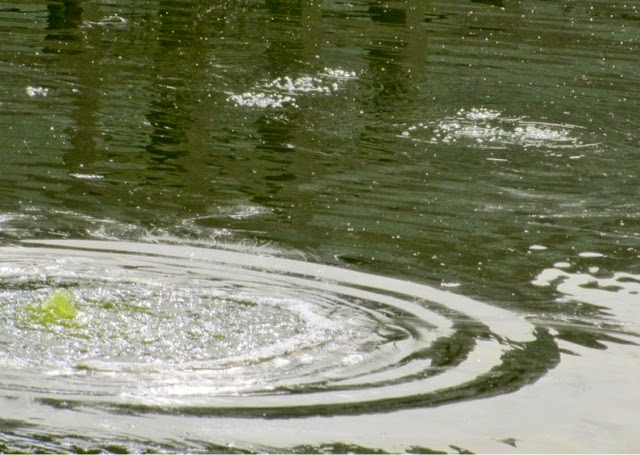LAKE PIT
A former quarry from the 1800s, asphalt and methane still bubble up from underground vents. Around it are life-sized statues of a mammoth family and a lone American mastodon.
Methane bubbles...
More bubbles...
ANTIQUE BISON
The Antique Bison is the most common plant-eater found at Rancho La Brea. At least 159 specimens have been retrieved.
Look at all the individual bones in the bison's tail.
Scott is trying to pull a paddle out of asphalt that simulates a stuck leg or foot. One of them I couldn't budge! No wonder mastodons got trapped and couldn't get out before predators attacked!
HARLAN'S GROUND SLOTH
The female and six year old youngster were trapped together in the asphalt.
Look at the teeth on this mastodon! Wow!
EXTINCT CAMEL
CALIFORNIA SABER-TOOTH CAT
The California Saber-tooth Cat was a powerful and efficient hunting machine. It appears they attacked young mammoths and mastodons using their teeth to stab the soft underbelly of their prey.
COLUMBIAN MAMMOTH
The Columbia Mammoth was the most common mammoth in North America during the Ice Age. This specimen is of average size, weighing 15,000 pounds and 12 feet tall.
Teeth
Tusks
Toes
MERRIAM'S GIANT CONDOR
This scavenger has a 12-foot wingspan.
DIRE WOLF SKULLS
Rancho La Brea is widely known for its incredibly rich fossil deposits. This display of 404 dire wolf skulls is only a portion of the 1600 wolves whose remains have been found here. It is thought that the Dire Wof attempted to feed on animals trapped in the asphalt and became trapped themselves.
FOSSIL LABORATORY
This woman is sorting micro fossils.
Looking at micro fossils under a microscope to determine if they are plant or animal.
Cleaning a bison neck bone (vertebra).
Tray upon tray of catalogued specimens.
SHORT-FACED BEAR
The Short-faced bear was larger than any present day North America bear; a foot taller and twice the weight of a grizzly.
OBSERVATION PIT
This was the first museum built in the park.
The jumble of bones is staged but an accurate depiction of what paleontologists uncover here at La Brea Tar Pits.
Our tour guide to the tar pits.
PIT 13
Scientists started digging here in 1914. Many of the fossils on display in the museum are from this pit.
PROJECT 23
PLEISTOCENE GARDEN























































































